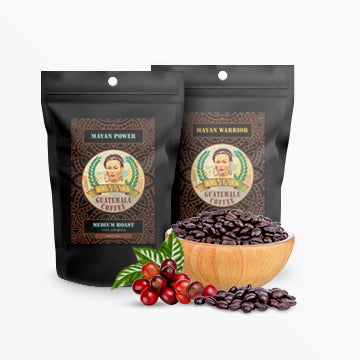How to Store Guatemalan Coffee Beans for Maximum Freshness
 Coffee loses 60% of its flavor compounds within just two weeks of roasting. That's a sobering reality for anyone who's invested in premium Guatemalan coffee beans. The volcanic soil of Guatemala's highlands produces some of the world's most complex and flavorful coffee. But without proper storage, even the finest beans from Antigua or Huehuetenango can turn into a disappointing cup.
Coffee loses 60% of its flavor compounds within just two weeks of roasting. That's a sobering reality for anyone who's invested in premium Guatemalan coffee beans. The volcanic soil of Guatemala's highlands produces some of the world's most complex and flavorful coffee. But without proper storage, even the finest beans from Antigua or Huehuetenango can turn into a disappointing cup.
At Via Guatemala, we've seen too many coffee lovers unknowingly sabotage their brewing experience with poor storage habits. The good news? Preserving your Guatemalan coffee's peak flavor is simpler than you might think.
Why Guatemalan Coffee Deserves Special Care
Guatemalan coffee stands apart from other origins. The high altitude growing conditions create dense beans packed with oils and aromatic compounds. These same characteristics that make Guatemalan coffee so special also make it more sensitive to environmental factors.
Our beans from regions like Atitlán and Cobán contain delicate flavor notes that can disappear quickly when exposed to air, light, heat, or moisture. Think of proper storage as protecting an investment in your daily coffee ritual.
The Four Enemies of Fresh Coffee
Understanding what damages coffee beans helps you make better storage decisions. Four main factors work against your Guatemalan coffee's freshness.
Air exposure is the biggest culprit. Oxygen triggers oxidation, which breaks down the oils that carry flavor. Once this process starts, it accelerates rapidly.
Light acts like a catalyst for chemical reactions in coffee beans. Both natural and artificial light can degrade flavor compounds over time.
Heat speeds up all the unwanted chemical processes. Temperature fluctuations are particularly harmful because they cause beans to expand and contract.
Moisture creates the perfect environment for mold and bacteria. It also dilutes the concentrated flavors you want to preserve.
The Gold Standard: Airtight Containers
Your first line of defense is an airtight container. We recommend opaque containers made from ceramic, glass, or food-grade plastic. The container should have a tight-fitting lid that creates a complete seal.
Avoid containers with one-way valves unless you're storing very freshly roasted beans. Most Guatemalan coffee from reputable roasters like us has already degassed sufficiently by the time it reaches you.
Size matters when choosing containers. Use a container that matches your coffee consumption. A large container half-filled with beans exposes your coffee to more air than necessary.
Temperature Control Strategies
Room temperature storage works best for most situations. Find a spot in your kitchen that stays consistently cool, ideally between 68-72°F.
Avoid storing coffee near heat sources like stoves, dishwashers, or sunny windows. The top of your refrigerator might seem convenient, but it's actually one of the warmest spots in your kitchen.
Some coffee enthusiasts debate freezer storage. While freezing can extend shelf life for long-term storage, it comes with risks. Frozen beans can absorb odors and develop condensation when removed. If you choose to freeze beans, use them within one month and never refreeze opened packages.
Location, Location, Location
Your pantry or a dedicated coffee cabinet makes an ideal storage spot. Look for areas that remain dark and maintain stable temperatures throughout the day.
Countertop storage works if you have an opaque container and consume your coffee quickly. Just keep it away from appliances that generate heat.
Avoid storing coffee in the refrigerator for daily use. The constant temperature changes and potential for moisture absorption outweigh any benefits.
Original Packaging Considerations
Many specialty coffee roasters, including Via Guatemala, package beans in bags with one-way valves and foil linings. These bags provide excellent protection when unopened.
Once opened, transfer beans to your airtight container or use bag clips designed specifically for coffee bags. Rolling down the bag and using a regular clip doesn't create an adequate seal.
Some coffee lovers keep beans in the original bag inside a larger airtight container. This double-layer approach works well if you buy coffee in larger quantities.
Portion Control for Peak Freshness
Buy only what you'll consume within 2-4 weeks after the roast date. This timeline ensures you're always drinking coffee at its peak flavor potential.
If you find a great deal on Guatemalan coffee or want to stock up on seasonal varieties from our collection, consider dividing large purchases into smaller portions. Store what you'll use immediately at room temperature and freeze the rest in weekly portions.
Label frozen portions with the roast date. This system helps you rotate stock and use older coffee first.
Signs Your Storage System Is Working
Fresh, properly stored Guatemalan coffee should smell aromatic when you open the container. You might notice subtle differences in aroma based on the specific region, whether it's the wine-like notes of Antigua or the chocolate undertones of Fraijanes.
Visual cues matter too. Beans should look uniform in color without any signs of oil on the surface (unless it's a dark roast where some oil is normal). Avoid beans that look dull or have white spots, which could indicate age or moisture problems.
Common Storage Mistakes to Avoid
Don't store coffee in the freezer door. This area experiences the most temperature fluctuation in your freezer.
Resist the urge to store beans in decorative glass jars on your counter unless they're in a consistently dark area. Light exposure happens faster than most people realize.
Never store coffee in the original paper bag for more than a few days. Paper bags offer minimal protection against air and moisture.
Avoid buying pre-ground coffee for storage. Ground coffee loses flavor much faster than whole beans because grinding increases surface area exposed to air.
Making the Most of Your Investment
Quality Guatemalan coffee represents a significant investment in your daily routine. Proper storage ensures every cup delivers the complex flavors you're paying for.
When you're ready to restock your coffee supply, visit our shop where we offer carefully selected beans from Guatemala's premier growing regions. You can also find our coffee on Amazon for convenient delivery.
Our roasting process preserves the unique characteristics of each region, but the final quality depends on how you store and brew the beans at home.
The Bottom Line
Storing Guatemalan coffee properly isn't complicated, but it requires attention to detail. Use airtight containers, control temperature and light exposure, and buy quantities that match your consumption rate.
These simple steps protect the investment you've made in premium coffee. More importantly, they ensure every morning starts with the full flavor experience that makes Guatemalan coffee special.
Ready to put these storage tips to work? Browse our selection of premium Guatemalan coffee beans and taste the difference proper storage makes in every cup.






